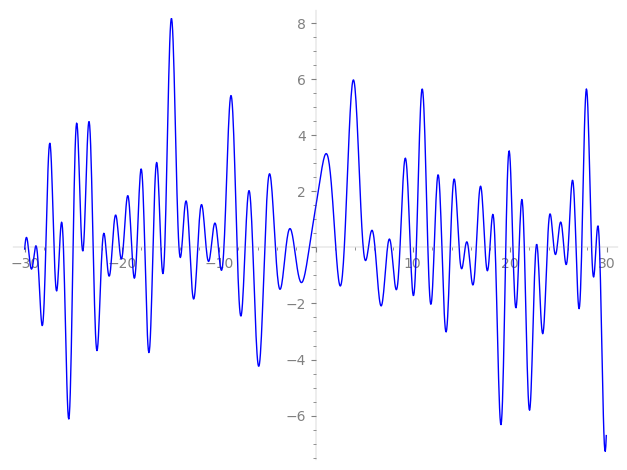| L(s) = 1 | − 1.37i·2-s + 0.0982·4-s + (0.697 + 0.402i)5-s + (0.0699 − 2.64i)7-s − 2.89i·8-s + (0.555 − 0.962i)10-s + (−4.56 − 2.63i)11-s + (−2.36 + 2.72i)13-s + (−3.64 − 0.0965i)14-s − 3.79·16-s − 0.560·17-s + (5.06 − 2.92i)19-s + (0.0685 + 0.0395i)20-s + (−3.63 + 6.29i)22-s − 1.60·23-s + ⋯ |
| L(s) = 1 | − 0.975i·2-s + 0.0491·4-s + (0.312 + 0.180i)5-s + (0.0264 − 0.999i)7-s − 1.02i·8-s + (0.175 − 0.304i)10-s + (−1.37 − 0.794i)11-s + (−0.656 + 0.754i)13-s + (−0.974 − 0.0257i)14-s − 0.948·16-s − 0.135·17-s + (1.16 − 0.670i)19-s + (0.0153 + 0.00884i)20-s + (−0.774 + 1.34i)22-s − 0.334·23-s + ⋯ |
\[\begin{aligned}\Lambda(s)=\mathstrut & 819 ^{s/2} \, \Gamma_{\C}(s) \, L(s)\cr =\mathstrut & (-0.937 + 0.348i)\, \overline{\Lambda}(2-s) \end{aligned}\]
\[\begin{aligned}\Lambda(s)=\mathstrut & 819 ^{s/2} \, \Gamma_{\C}(s+1/2) \, L(s)\cr =\mathstrut & (-0.937 + 0.348i)\, \overline{\Lambda}(1-s) \end{aligned}\]
Particular Values
| \(L(1)\) |
\(\approx\) |
\(0.252860 - 1.40722i\) |
| \(L(\frac12)\) |
\(\approx\) |
\(0.252860 - 1.40722i\) |
| \(L(\frac{3}{2})\) |
|
not available |
| \(L(1)\) |
|
not available |
\(L(s) = \displaystyle \prod_{p} F_p(p^{-s})^{-1} \)
| $p$ | $F_p(T)$ |
|---|
| bad | 3 | \( 1 \) |
| 7 | \( 1 + (-0.0699 + 2.64i)T \) |
| 13 | \( 1 + (2.36 - 2.72i)T \) |
| good | 2 | \( 1 + 1.37iT - 2T^{2} \) |
| 5 | \( 1 + (-0.697 - 0.402i)T + (2.5 + 4.33i)T^{2} \) |
| 11 | \( 1 + (4.56 + 2.63i)T + (5.5 + 9.52i)T^{2} \) |
| 17 | \( 1 + 0.560T + 17T^{2} \) |
| 19 | \( 1 + (-5.06 + 2.92i)T + (9.5 - 16.4i)T^{2} \) |
| 23 | \( 1 + 1.60T + 23T^{2} \) |
| 29 | \( 1 + (-1.14 - 1.97i)T + (-14.5 + 25.1i)T^{2} \) |
| 31 | \( 1 + (-3.01 + 1.73i)T + (15.5 - 26.8i)T^{2} \) |
| 37 | \( 1 + 1.24iT - 37T^{2} \) |
| 41 | \( 1 + (0.803 - 0.463i)T + (20.5 - 35.5i)T^{2} \) |
| 43 | \( 1 + (-2.22 + 3.85i)T + (-21.5 - 37.2i)T^{2} \) |
| 47 | \( 1 + (-3.32 - 1.92i)T + (23.5 + 40.7i)T^{2} \) |
| 53 | \( 1 + (-2.72 - 4.72i)T + (-26.5 + 45.8i)T^{2} \) |
| 59 | \( 1 + 10.9iT - 59T^{2} \) |
| 61 | \( 1 + (3.65 + 6.32i)T + (-30.5 + 52.8i)T^{2} \) |
| 67 | \( 1 + (-6.36 - 3.67i)T + (33.5 + 58.0i)T^{2} \) |
| 71 | \( 1 + (-8.06 - 4.65i)T + (35.5 + 61.4i)T^{2} \) |
| 73 | \( 1 + (-4.33 + 2.50i)T + (36.5 - 63.2i)T^{2} \) |
| 79 | \( 1 + (5.68 - 9.84i)T + (-39.5 - 68.4i)T^{2} \) |
| 83 | \( 1 - 5.81iT - 83T^{2} \) |
| 89 | \( 1 - 5.00iT - 89T^{2} \) |
| 97 | \( 1 + (-9.22 - 5.32i)T + (48.5 + 84.0i)T^{2} \) |
| show more | |
| show less | |
\(L(s) = \displaystyle\prod_p \ \prod_{j=1}^{2} (1 - \alpha_{j,p}\, p^{-s})^{-1}\)
Imaginary part of the first few zeros on the critical line
−10.03217599010286182468897967636, −9.461985615841985327806773316918, −8.105736098069650251529794648467, −7.27577540990975581260286754602, −6.49130688523390662890622775060, −5.25288132747272609209537016686, −4.15532822465887124993726475057, −3.06515776834280678016909051824, −2.20542738563265175864166555907, −0.66073079644487281432416975410,
2.06848503092773324202582424983, 2.94494743388972853970230904706, 4.89459793647316312627604413028, 5.43312423117105453012434144629, 6.10720370498388741251707275427, 7.39817957994397067459109118324, 7.79166170021658643513769807664, 8.687761542873773675645635361965, 9.745990971639688071901785331748, 10.37167457555197698694103058998

